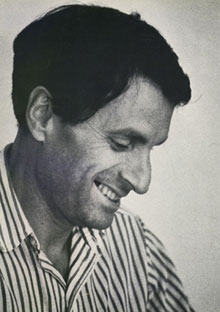Difference between revisions of "Xenakis, Iannis"
| Line 13: | Line 13: | ||
<!-- Enter the composer's biography here --> | <!-- Enter the composer's biography here --> | ||
| + | ---- | ||
| + | Iannis Xenakis was a composer of Greek heritage and Romanian birth, known for his revolutionary ideas regarding the systematic, mathematical organization of music and its structural parallels with architecture, and for his pioneering work in electronic music. Xenakis' initial exposure to music came in the first ten years of his life, when he was surrounded by the folk music of the Romanian countryside and the liturgy of the Byzantine Orthodox Church. In 1942, when his family moved to Greece, he was exposed to the music of Beethoven and Brahms for the first time. | ||
| + | His life grew turbulent when he entered Athens Polytechnic with the intent of becoming an engineer. When Greece was invaded during the World War II, Xenakis became passionately involved with resistance and liberation groups, first protesting against Nazi rule and, later, opposing the British, who, in 1944, drove out the Germans but sided with right-wing politicians against the Greek National Liberation Front. Xenakis was seriously wounded, his face disfigured, when he was hit by a British shell; he also lost vision in one eye. As a member of the resistance, he was eventually arrested and sentenced to death. He escaped in 1947, hoping to reach the United States. He ended up settling in Paris, however, and taking French nationality. In Paris, Xenakis made numerous important contacts, befriending Messiaen, Honegger, Mihaud, and the celebrated architect Le Corbusier, who were all impressed by his innovative and brilliantly intellectual approach to music. Working with Le Corbusier, Xenakis was highly involved with civil planning and architecture, designing some landmark sites throughout the world. For him, architecture was musical, and music was architectural. He frequently used one to inspire the other, basing pieces on computer programs and complex mathematical equations. This approach resulted in highly theoretical, systematic music characterized by intricately calculated rhythms, dense and often explosive textural fields, extended timbral effects, and "clouds" of sound that contain countless "particles." Some of his most important works include the orchestral Metastasis (1954), Pithoprakta (1956), Nomos Alpha for solo cello, and groundbreaking electronic works such as Bohor I, and Concret P-H. Xenakis was the founder of the EMAMu in Paris and its American counterpart, the Center for Musical Mathematics and Automation in Bloomington, Indiana.<ref>http://www.allmusic.com/artist/iannis-xenakis-q8133/biography</ref> | ||
| + | - Graham Olson | ||
== Works for Percussion == | == Works for Percussion == | ||
Revision as of 01:35, 12 March 2012
Biography
Born: May 29, 1922 - Braïla, Romania
Died: February 04, 2001 - Paris, France
Country: Greece
Studies: private college in Spetsai, Athens Polytechnic; Ecole Normale de Musique, Paris
Teachers: Arthur Honegger; Darius Milhaud
Iannis Xenakis was a composer of Greek heritage and Romanian birth, known for his revolutionary ideas regarding the systematic, mathematical organization of music and its structural parallels with architecture, and for his pioneering work in electronic music. Xenakis' initial exposure to music came in the first ten years of his life, when he was surrounded by the folk music of the Romanian countryside and the liturgy of the Byzantine Orthodox Church. In 1942, when his family moved to Greece, he was exposed to the music of Beethoven and Brahms for the first time.
His life grew turbulent when he entered Athens Polytechnic with the intent of becoming an engineer. When Greece was invaded during the World War II, Xenakis became passionately involved with resistance and liberation groups, first protesting against Nazi rule and, later, opposing the British, who, in 1944, drove out the Germans but sided with right-wing politicians against the Greek National Liberation Front. Xenakis was seriously wounded, his face disfigured, when he was hit by a British shell; he also lost vision in one eye. As a member of the resistance, he was eventually arrested and sentenced to death. He escaped in 1947, hoping to reach the United States. He ended up settling in Paris, however, and taking French nationality. In Paris, Xenakis made numerous important contacts, befriending Messiaen, Honegger, Mihaud, and the celebrated architect Le Corbusier, who were all impressed by his innovative and brilliantly intellectual approach to music. Working with Le Corbusier, Xenakis was highly involved with civil planning and architecture, designing some landmark sites throughout the world. For him, architecture was musical, and music was architectural. He frequently used one to inspire the other, basing pieces on computer programs and complex mathematical equations. This approach resulted in highly theoretical, systematic music characterized by intricately calculated rhythms, dense and often explosive textural fields, extended timbral effects, and "clouds" of sound that contain countless "particles." Some of his most important works include the orchestral Metastasis (1954), Pithoprakta (1956), Nomos Alpha for solo cello, and groundbreaking electronic works such as Bohor I, and Concret P-H. Xenakis was the founder of the EMAMu in Paris and its American counterpart, the Center for Musical Mathematics and Automation in Bloomington, Indiana.[1] - Graham Olson
Works for Percussion
Aïs - Multiple Percussion; Voice; Orchestra
Dmaathen - Multiple Percussion; Oboe
Komboï - Multiple Percussion; Harpsichord
Okho - Percussion Trio - Djembe
Oophaa - Multiple Percussion; Harpsichord
Persephassa - Percussion Sextet
Pléiades - Percussion Sextet
Psappha - Multiple Percussion Solo
Rebonds - Multiple Percussion Solo
References
